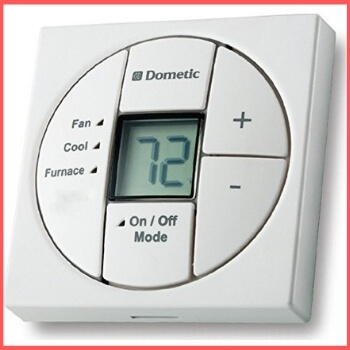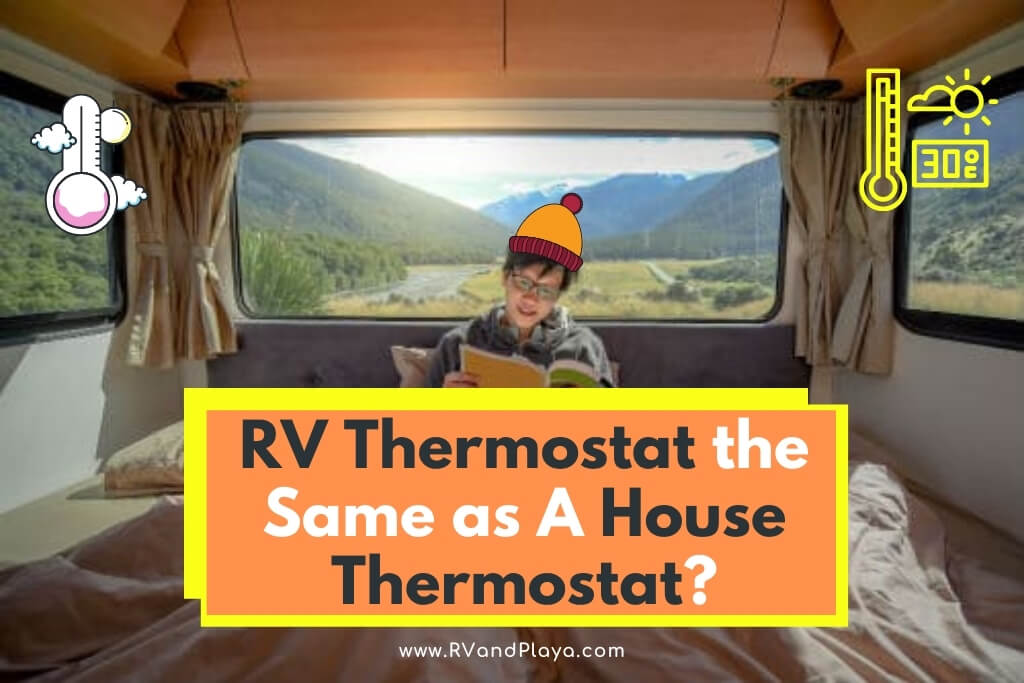An RV is equipped with all the conveniences of home. It is, in fact, a rolling house. Some are big enough to come with two thermostats. If it has all of the amenities of home, the question is, is an RV thermostat the same as a house thermostat?
Is an RV thermostat the same as a house thermostat? No, RV thermostats are not the same as house thermostats. RV thermostats run on 12 volts DC power source while home thermostats run on 24 volts AC power source. It has been implied that some home thermostats may work in an RV, but it is not recommended.
It appears the rolling houses may have some variation from residential housing that needs to be taken into consideration. One of them being the use of AC and DC voltage.
So, what’s the difference? The passage below provides those answers in detail.
Related: Do RV Thermostats Go Bad? How To Check It?
Table of Contents
What Is The Difference Between an AC And DC Power Source
You would probably be more familiar with this phrase if you saw it as AC/DC. Yes, the Australian rock band took its name from Alternating Current (AC) and Direct Current (DC).
These currents define how a current flows into a circuit.
Direct Current flows one way while Alternating Current can change directions. This means the flow of a circuit may reverse its direction with AC because the current has changed course.
Related: What is an Inverter in an RV and Why Do You Need it?
It can be safely said that residential homes are overwhelmingly wired for AC, while DC refers to battery power. Now, this is where it gets tricky. RVs have both AC and DC electrical systems.
RV AC and DC Electrical System Set Up
RVs have three electrical systems that operate separately from one another:
- 12-volt DC automotive system
- 12-volt DC coach system; and
- 120-volt AC coach system
Wait, what? Yes, AC system. So, why wouldn’t you be able to use a house thermostat for the RV? Let’s delve a bit deeper.

Most campgrounds have 120-volt posts to plug your RV into that supplies power for the entire RV. The 120-volt AC power is required to run:
- Microwave
- Roof Air Conditioner
- Refrigerator (electrical mode); and
- Electrical Outlets
Everything else in the RV, including the thermostat, works off the 12-volt DC power. The caveat here is, while plugged in, the 120-volt AC current is converted to 12-volt DC current for all items in the RV that work off of the 12-volt DC. These items are:
- Overhead Lights
- Furnace Fan
- Range Overhead Fan
- Bathroom Vent Fan
- Water Pump
- LP Gas Leak Detector
- Stereo; and
- Refrigerator (gas mode)
If you are not plugged in, you can use the 12-volt DC system with a 12-volt deep cycle marine battery. As long as the RV batteries are charged, the RV will be powered, and you can use everything on that system.
Related reading: Can a TV Run on a 12V Battery? [This Is How]
About RV Onboard Generator Function
If your RV is equipped with an onboard power generator, you have access to 120-volt AC power at your convenience. Onboard generators make the RV completely self-sufficient.
Related: 9 Easy Tips to Keep Your Dog Warm While Camping
In motorhomes, the generator fuel is taken directly from the tank; however, it is designed to stop when the tank reads ¼ left so that you can get home.
The circuit board for the RV looks a lot like your home distribution panel. You will see a 120-volt AC side and the automotive 12-volt DC side with blade fuses.
So, on the AC/DC struggle, bringing a home thermostat that runs on AC into an RV thermostat situation that runs on DC is not an ideal match. But, can you convert power from DC to AC or vice versa to use the thermostat?
Related reading: How to Use a Generator with a Travel Trailer: Complete Guide
RV Converts & Invertors
It is essential to understand the difference between what a converter does and what an inverter does. This section will describe their function in greater detail.
RV Converter Functions
The converters main job is to reduce 120-volts AC down to 12-volt DC when your RV is plugged in or when the generator is on. The converter uses the AC volts to ensures that all 12-volt appliances and accessories are supplied with power.
If you are not plugged into a power source, the battery will power all 12-volt devices and accessories by itself.
Its primary function is to charge the battery that runs the 12-volt appliances and accessories, so you don’t drain it.
Since the thermostat is still running off the 12-volt DC battery being charged by the 120-volt AC, it still does not function like a house thermostat. The thermostat remains battery operated.
Related: How Many Batteries Do I Need for My Inverter? [Incl. 8 Examples]
RV Inverter Functions
Inverters are used when you aren’t plugged into an AC power source or when you don’t have an onboard generator.
Opposite from a converter, an inverter takes power from the 12-volt DC battery and electronically changes it to a 120-volt AC source.
Without a power source, the inverter will provide limited power to appliances that run on the AC item list, such as microwaves or TVs.
It is vital to know the capacity of the inverter you use. Inverters have to produce 10x the voltage going from 12 volts to 120 volts, so it pulls more power from your battery to do so.
It is vital to know the capacity of the inverter you use. Inverters have to produce 10x the voltage going from 12 volts to 120 volts, so it pulls more power from your battery to do so.
Basically, a TV that needs a 5 Amp AC draw means the inverter takes 50 Amps from the batteries.
Inverters are used for short supplies of power, like watching a TV show as not to drain the battery. Inverters are not equipped to power larger appliances such as air-conditioners. The battery would drain quickly.
Related reading: What is an Inverter in an RV and Why Do You Need it?
The thermostat remains on the 12-volt DC system. So, an inverter that takes power from that system to run another appliance on the AC system solidifies the fact that the thermostat from a house AC system is not the same as an RV thermostat, and they are not interchangeable.
Now that we understand all of the differences in the RV operating system and that the RV thermostat runs on DC while the house thermostat runs on AC power, let’s introduce a wrinkle.
Battery-Operated Thermostats
There is indeed a battery-operated thermostat. The Hunter Thermostat offers a battery-operated system that, with a little wiring finesse, allows for a smooth transition from the home thermostat to RV thermostat.
Notice, if the batteries die, so does your thermostat. For those that are familiar with wiring on thermostats, this may be the happy medium for RV goers.
Related reading: 4 Essential Reasons Travel Trailers Have Batteries [Must-read]
There is controversy in the RV world as to whether or not house battery-operated thermostats work. This is largely because of the wiring that has to manipulated within the thermostat itself. If in doubt, it is probably best to stick with traditional RV thermostats.
Most RV owners tend to stay with thermostats that are built to run with the standard RV battery set up.
New innovations come all the time, and in the future, there may be an easy way to convert a home thermostat to an RV thermostat or maybe one that serves as a dual purpose without rewiring. That remains to be seen.
Read also: How Many Batteries Do I Need for My Inverter? [Incl. 8 Examples]
The Hot & Cold of RVs
RVs high appeal is that you bring all the comforts of home with you on the road. The sense of freedom in being mobile is undeniable.
You can remain connected through the world with Wi-Fi and satellite while traveling and participate in electronics on a selective basis.
RVs allow for easy, smooth get-aways.
One of the comforts we bring with us is the RV thermostat. Without a comfortable environment to escape from after an outdoor excursion, camping isn’t nearly as fun.
Make sure your RV is equipped with the right thermostat. Home thermostats are usually AC, and RV thermostats are DC.
It may be possible for the two to find a happy medium in a battery-powered thermostat, but the wiring will take some delicate hands to make it work.
RV DIGITAL THERMOSTAT CHEAP AND EASY INSTALL! >> Check out the video below:
Recommended Reading
For more helpful articles about RVs please check out our articles below:
RV Propane Refill Near Me – Stations & Locations [UPDATED]
What Size Air Compressor Do You Need to Winterize an RV?
5 Practical Ways To Unfreeze Water Lines In RVs (That Actually Work)
Do Travel Trailers Need Snow Chains? – Best Advice
Recent Posts
Is Toyota Remote Connect Free? (Subscription, Services Plans)
Does Toyota Remote Connect have an included trial? It used to be the case that, when you bought a new car, you made one straightforward payment and that was it. Now, it feels like there are...
Toyota Safety Connect: What It Is And Why You Need It? Whether you’re buying a new Toyota or you’ve had one for a while you will have been given the hard sell on their Connected Services but do...

